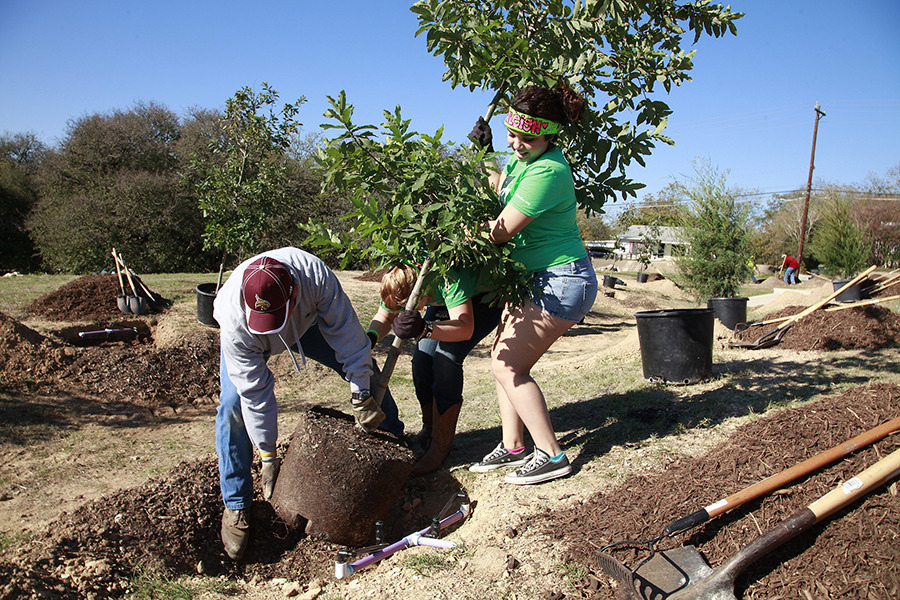Plant a tree
Plant a young tree seedling in soil, learn proper digging, watering, and care steps, and observe growth over weeks to months.



Step-by-step guide to plant a tree
Life Cycle of a Plant for Kids! | Learn Parts of a Plant 🌱 | Twinkl USA
Step 1
Choose a sunny spot that gets at least six hours of light and has room for the tree to grow.
Step 2
Clear a 2-foot circle of grass and weeds where you will plant the seedling.
Step 3
Measure the seedling's root ball depth and width with a ruler or tape measure.
Step 4
Dig a hole that is the same depth as the root ball and about twice as wide.
Step 5
Carefully remove the seedling from its pot.
Step 6
Gently loosen the outer roots with your fingers so they can spread out.
Step 7
Place the seedling into the hole so the top of the root ball is level with the ground.
Step 8
Backfill the hole with the soil you removed, covering the roots evenly.
Step 9
Gently press the soil down around the roots to remove big air pockets.
Step 10
Water the newly planted tree deeply until the soil is soaked and water starts to run off.
Step 11
Spread 2 to 3 inches of mulch in a ring around the tree leaving a 2-inch space from the trunk.
Step 12
If the seedling is tall or in a windy spot place a stake beside it and tie the trunk loosely with the soft tie.
Step 13
Write the planting date and the seedling's height in your notebook and note how often you will water.
Step 14
Check the tree once a week; water during dry spells and write one short observation in your notebook each week.
Step 15
Share your finished creation on DIY.org
Final steps
You're almost there! Complete all the steps, bring your creation to life, post it, and conquer the challenge!


Help!?
If I can't find a soft tree tie, bagged mulch, or a tape measure, what household substitutes can I use?
Use a strip of an old cotton T-shirt as the soft tie when you place a stake beside it and tie the trunk loosely, spread shredded leaves or grass clippings as 2–3 inches of mulch in a ring around the tree, and use a ruler or a piece of string measured against a yardstick to measure the seedling's root ball depth and width.
What should I do if the seedling keeps leaning or the hole ends up too deep or too shallow?
If the top of the root ball isn't level with the ground or the seedling leans, lift or add soil so the top of the root ball is level with the ground, place a stake beside it and tie the trunk loosely with the soft tie, then gently press the soil around the roots to remove big air pockets and water deeply until runoff.
How can I adapt planting steps for different age groups of children?
For ages 3–6 let them help clear the 2‑foot circle and pour water under supervision, for ages 7–10 have them measure the seedling's root ball with a ruler and gently loosen outer roots, and for teens assign digging the hole to the measured depth, staking and tying the tree, and keeping the notebook with weekly observations.
How can we extend or personalize the project after planting the seedling?
Personalize by painting and attaching a wooden stake with the planting date and seedling's name, keep a photo log and the notebook of weekly observations and watering schedule, add a simple rain gauge for dry spells, and share the finished creation on DIY.org.
Watch videos on how to plant a tree
Planting a Tree with Kids:Step-by-Step Guide for Young Gardeners|How to Plant a Tree|Kid Zone A to Z
Facts about gardening for kids
🌳 A single mature tree can absorb about 22 kg (48 lb) of CO₂ per year and helps produce oxygen for people (exact numbers vary by species).
🐦 Even one planted tree can attract birds, insects, and other wildlife, creating a tiny neighborhood ecosystem.
💧 New trees benefit from deep, infrequent watering — roughly once or twice a week (amount depends on species and weather) to encourage deep roots.
🌱 Seedlings grow most of their tiny feeder roots in the top 6–12 inches of soil, so loose, deep soil helps roots spread.
🕒 Trees often take 1–3 years to become well established below ground and decades to reach full size — planting is a long-term gift!
How do you plant a young tree seedling?
What materials do I need to plant a tree seedling?
What ages is planting a tree suitable for?
What are the benefits, safety tips, or variations for planting a tree?


One subscription, many ways to play and learn.
Only $6.99 after trial. No credit card required



